
Mar 6, 2020

In this issue, we learn about ketogenic diet as a potential treatment for SCI, meet some interesting #WomenInScience, and get a preview of a study about to take place in India. Plus: a selection of the last decade’s most exciting papers, an update from PARC, and some news from our partners.
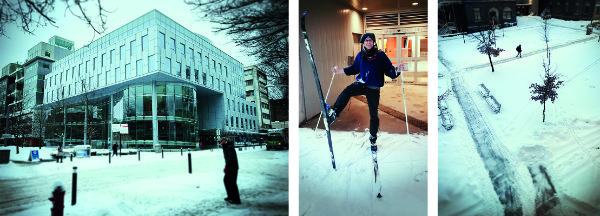
 You’ve probably heard about the ketogenic (or “keto”) diet—the high-fat, low-carbohydrate diet that has been used as a treatment for epilepsy in children and has recently gained popularity as a weight-loss fad diet / lifestyle choice. But did you know that ICORD’s director and researcher Dr. Wolfram Tetzlaff and his team have been investigating whether following a ketogenic diet can improve functional recovery after spinal cord injury?
You’ve probably heard about the ketogenic (or “keto”) diet—the high-fat, low-carbohydrate diet that has been used as a treatment for epilepsy in children and has recently gained popularity as a weight-loss fad diet / lifestyle choice. But did you know that ICORD’s director and researcher Dr. Wolfram Tetzlaff and his team have been investigating whether following a ketogenic diet can improve functional recovery after spinal cord injury?
In the mid-2000s, Dr. Ward Plunet, a PhD student and later, research scientist, in Dr. Tetzlaff’s lab, was investigating whether intermittent fasting started after injury could improve outcomes after SCI. He was later joined by postdoctoral fellow Dr. Femke Streijger. They published a study in 2008 showing improvements in rodent models of SCI. However, translating this discovery into human patients was problematic. “The idea of asking newly-injured human patients to start a regimen of intermittent fasting was not met with enthusiasm from acute care-givers, who were worried about excessive weight losses in a population that is already losing weight acutely after injury,” said Dr. Tetzlaff. “However, since Dr. Plunet demonstrated that intermittent fasting increases ketone levels intermittently, and since ketones were already known to be neuroprotective, we decided to test a ketogenic diet. This would increase ketones without the need to withhold calories,” he explained.
A paper published by Tetzlaff lab researchers in 2013 showed that rodents fed a ketogenic diet following SCI were better able to use their forelimbs than rodents fed a standard carbohydrate-based diet. Dr. Tetzlaff and his team provided animal data to Dr. Ceren Yarar-Fischer of the University of Alabama at Birmingham, who used the data in an application to the US National Institutes of Health (NIH) for funding to run a randomized controlled clinical trial of ketogenic diet after acute SCI. Her grant was funded, and following a small pilot study, she is now enrolling participants.
Dr. Tetzlaff and his team provided animal data to Dr. Ceren Yarar-Fischer of the University of Alabama at Birmingham, who used the data in an application to the US National Institutes of Health (NIH) for funding to run a randomized controlled clinical trial of ketogenic diet after acute SCI. Her grant was funded, and following a small pilot study, she is now enrolling participants.
“For now, this is the only location where this approach is being tested and we have to await the outcome from this trial to determine whether more people need to be trialed in other locations and whether this could be recommended as a standard of care,” said Dr. Tetzlaff.
Recently, Dr. Tetzlaff and his team have been studying whether using a ketone ester drink would work as well as a full ketogenic diet. Ketone esters can increase blood levels of ketones without the need of adhering to a strict diet.
When asked if people with chronic SCI should try following a keto diet, Dr. Tetzlaff was cautious. “This has not been tested yet, so I can’t recommend it. However, people with chronic SCI are prone to metabolic disease including diabetes, and since Ketogenic diet is effective in 90% of the people with type 2 diabetes, it is conceivable that people with chronic SCI may benefit from it. This should not be started without seeking the advice of a physician and dietician, though, since side effects are possible. That being said, there should be no harm in avoiding refined sugars and highly-processed foods, and eating a diet rich in vegetables, nuts, healthy oils, fish, and low-sugar fruits.”


On February 11, we celebrated the International Day for Women and Girls in Science by profiling ten amazing ICORD women–from a high school student just starting out, to a career research scientist retiring this month–who offer a variety of perspectives on what it’s like to be a woman in science.
Click here to meet them.
The UN International Day for Women and Girls in Science exists because fewer than 30% of researchers worldwide are women, and globally, female student enrolment in STEM is very low. The goal of establishing this annual day is to promote gender equality in access to and participation in science.


![Wheelchair dancer Vince Preap and dance partner Cadi Fortes. June 24 2016, Photo by Francis Georgian, Reporter Jenny Lee, Location UBC. [PNG Merlin Archive]](https://icord.org/wp-content/uploads/2020/03/dancing-couple-winter-2020-icordian-300x225.jpeg) Dr. Andrei Krassioukov is leading a team of researchers to India to study the physical demands of wheelchair dance. Research assistant Amanda Lee and postdoctoral fellows Drs. Rahul Sachdeva and Tom Nightingalewill work with Dr. Krassioukov to measure energy expenditure and cardiovascular responses in 25 people with SCI and their able-bodied partners.
Dr. Andrei Krassioukov is leading a team of researchers to India to study the physical demands of wheelchair dance. Research assistant Amanda Lee and postdoctoral fellows Drs. Rahul Sachdeva and Tom Nightingalewill work with Dr. Krassioukov to measure energy expenditure and cardiovascular responses in 25 people with SCI and their able-bodied partners.
While the benefits of exercise after SCI are well established, the specific effects of wheelchair dancing have not been researched, despite it being a popular sport for people with SCI. Wheelchair dancing has also captured the interest of the International Paralympic Committee.
“Ultimately, findings from this study will help guide Paralympic classification and guidelines for competitive wheelchair dancers. We also hope results will provide information to the SCI community about a popular, accessible form of exercise that could help improve their cardiovascular health and overall quality of life,” said Amanda. The Vancouver-based FUSE Wheelchair Dance Society helped Dr. Krassioukov and his team develop several dance routines and conduct pilot tests to collect data at the Blusson Spinal Cord Centre. Later this month, the research team will be heading to New Delhi to collaborate with Dr. Harvinder Chhabra at the Indian Spinal Injuries Centre (pictured above).
The Vancouver-based FUSE Wheelchair Dance Society helped Dr. Krassioukov and his team develop several dance routines and conduct pilot tests to collect data at the Blusson Spinal Cord Centre. Later this month, the research team will be heading to New Delhi to collaborate with Dr. Harvinder Chhabra at the Indian Spinal Injuries Centre (pictured above).
Why India? “Wheelchair dance is quite well established there, with an incredible community of veteran dancers who use a variety of mobility aids ranging from manual wheelchairs to power wheelchairs to crutches. Indian dancers have gained international recognition in competitions and theatre performances,” explained Amanda. Through their collaboration with Dr. Chhabra, the research team will have access to both novice dancers and athletes with years of professional dance experience (the latter being much harder to recruit in Vancouver!).


by Jocelyn Chan
We started the new decade by asking our researchers to look back, and tell us about their most exciting publications from the past ten years. Here are a few highlights:
Spinal cord perfusion pressure predicts neurologic recovery in acute spinal cord injury.
- Drs. Brian Kwon and Christopher West published the first-ever study to show that spinal cord perfusion pressure (SCPP) is a better predictor of neurologic recovery than standard blood pressure monitoring in patients with acute SCI. This valuable clinical insight for human SCI management and led to the launch of the CASPER clinical trial. This paper was awarded the 2018 APPLE Award from the American Spinal Injuries Association for the best paper in the field of SCI, as well as the 2019 Brain Canada Tator-Turnbull award for the top paper in neuroscience by Canadian researchers.
Association of epidural stimulation with cardiovascular function in an individual with spinal cord injury.
- Dr. Christopher West and his colleagues in the Krassioukov Lab were the first to demonstrate that an implanted epidural stimulation device could be used to optimize immediately restore cardiovascular function in an individual with severe autonomic instability (very low blood pressure when moving from lying down to sitting up, known as orthostatic hypotension, or OR). Other studies of epidural stimulation for SCI are underway.
Differential histopathology and behavioral outcomes eight weeks after rat spinal cord injury by contusion, dislocation, and distraction mechanisms.
- This study, by Dr. Tom Oxland and his colleagues, was challenging to complete and took the culmination of many years of work to develop the models. The paper demonstrates that the pattern of spinal cord damage and the animal behaviour at 8 weeks post-injury is affected by the type of injury experienced. This could mean that different types of treatments should be used depending on the specific injury type.
Early administration of gabapentinoids improves motor recovery after human spinal cord injury.
- This paper by Dr. John Kramer and his colleagues is exciting because it offers a potential to reposition gabapentinoids, an approved medication already commonly administered to people with spinal cord injury, as an adjunctive therapy to drive greater motor recovery. Interestingly, researchers in Germany have also recently published a paper showing that gabapentinoids can promote axon regeneration after SCI.
We’ll be posting a complete list of “most exciting papers” on our website soon. Stay tuned!


By Dr. Tania Lam
It has been almost ten years since we held our initial discussions about the opening of a gym for the spinal cord injury community on the ground floor of the Blusson Spinal Cord Centre. Since that time, in my role as faculty advisor for the Yuel Family Physical Activity Research Centre (PARC), I have been so fulfilled to see how PARC has transformed, from a small operation that ‘soft-opened’ in 2013 serving about 45 participants, to more than 400 registrants today. Along the way, more than 250 volunteers and 23 Work Learn students from UBC have joined us to help realize the vision and potential of PARC as the vibrant and productive community space it has become. I’m very proud to see how the students at PARC have so enthusiastically embraced their role as leaders and learners, and as mentors to each other and to our participants. Likewise, I have been immensely touched by the way so many of our PARC participants have become mentors and role models, both among themselves and to all the students who have flowed through PARC. 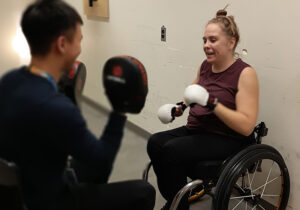 Through this unique collaborative environment, we have been able to collect valuable information about the impact of PARC on participants’ quality of life and health. We have also developed new exercise programs, such as arm ‘spin’ classes and boxercise, which are now in the process of being adopted by some of our city’s community centres. The recent launch of our new Personal Training program and our continued commitment to creating professional development content to spread the knowledge and experience of PARC promises to further expand our impact on the community.
Through this unique collaborative environment, we have been able to collect valuable information about the impact of PARC on participants’ quality of life and health. We have also developed new exercise programs, such as arm ‘spin’ classes and boxercise, which are now in the process of being adopted by some of our city’s community centres. The recent launch of our new Personal Training program and our continued commitment to creating professional development content to spread the knowledge and experience of PARC promises to further expand our impact on the community.
I am excited to announce that Dr. Andrea Bundon has taken over as Faculty Advisor for PARC. As a scholar in disability studies, with a focus on inclusion and participation in sport and physical activity, she brings a very relevant perspective and expertise to PARC. Dr. Bundon will lead exciting new research initiatives as PARC continues to expand, not only within, but also beyond our walls to impact the larger community locally and internationally.
It has been truly a pleasure to witness the unique community spirit that has developed out of this space. I am excited to see PARC continue to strengthen and grow as a community and as a model for inclusion and participation.
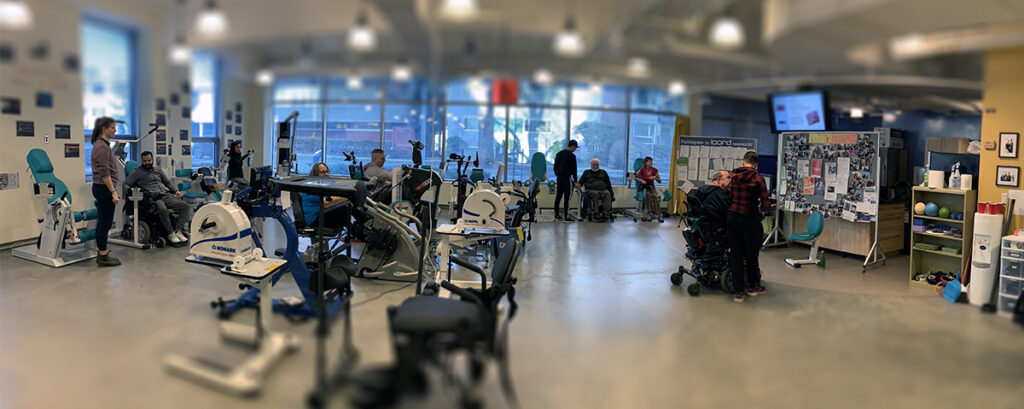

We’re now accepting applications for next year’s summer research program for Indigenous youth, and we’re excited to be partnering with the UBC School of Biomedical Engineering to offer at least seven placements in 2020. If you know anyone who might be interested in learning about SCI research and biomedical engineering, please let them know about this paid summer program!
Application deadline: April 3
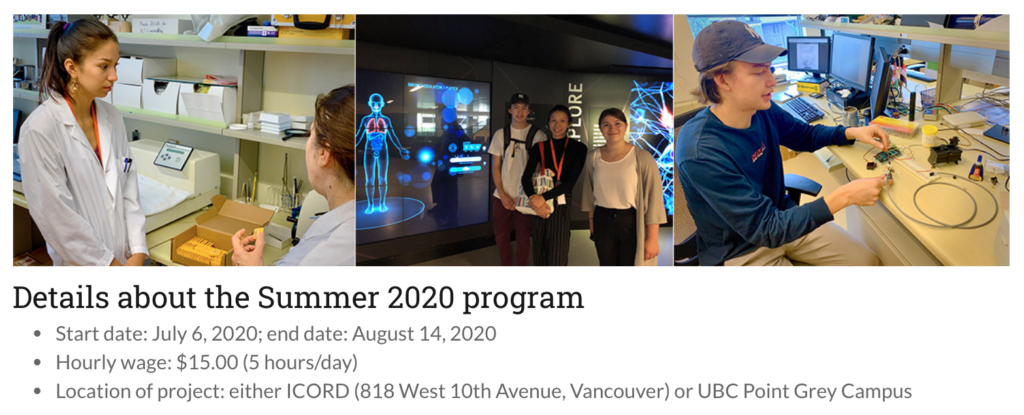

Interested in helping ICORD researchers make SCI preventable, livable, and curable? These research studies (and more) are in need of participants!
Modified rowing machine for cardiovascular exercise
![]() ICORD researchers Drs. Bonita Sawatzky, Ben Mortenson, Carolyn Sparrey, and Jaimie Borisoff want to compare the energetic and physiologic impact of adaptive rowing systems to traditional hand cycle exercise. A secondary objective of this study is to explore the usability of the adaptive rowing system and the traditional arm crank ergometer through users’ perspectives. Click here for more.
ICORD researchers Drs. Bonita Sawatzky, Ben Mortenson, Carolyn Sparrey, and Jaimie Borisoff want to compare the energetic and physiologic impact of adaptive rowing systems to traditional hand cycle exercise. A secondary objective of this study is to explore the usability of the adaptive rowing system and the traditional arm crank ergometer through users’ perspectives. Click here for more.
Factors that influence physical activity among people with SCI who ambulate
![]() In an effort to explore what constitutes quality physical activity among individuals with a spinal cord injury who walk, Dr. Kathleen Martin Ginis and Ph.D. student Sarah Lawrason, from the School of Health and Exercise Sciences at UBC Okanagan, are requesting permission to examine your physical activity participation experiences. Click here for more.
In an effort to explore what constitutes quality physical activity among individuals with a spinal cord injury who walk, Dr. Kathleen Martin Ginis and Ph.D. student Sarah Lawrason, from the School of Health and Exercise Sciences at UBC Okanagan, are requesting permission to examine your physical activity participation experiences. Click here for more.
User perceptions of power-assist devices for manual wheelchairs
![]() Power-assist devices are electric add-ons that can be attached to manual wheelchairs. These devices may enable users to access diverse environments, increase their sense of choice and independence, and conserve energy. In this study, participants will engage in focus groups and interviews to share perceptions of existing power-assist devices and provide feedback on needed and preferred improvements. Click here for more.
Power-assist devices are electric add-ons that can be attached to manual wheelchairs. These devices may enable users to access diverse environments, increase their sense of choice and independence, and conserve energy. In this study, participants will engage in focus groups and interviews to share perceptions of existing power-assist devices and provide feedback on needed and preferred improvements. Click here for more.
 Did you know that volunteers at our SCI Community Resource Centre prepare summaries of scientific papers and post them on our SCInfo blog? If you’re interested in what’s going on in SCI research around the world, this is a good place to look.
Did you know that volunteers at our SCI Community Resource Centre prepare summaries of scientific papers and post them on our SCInfo blog? If you’re interested in what’s going on in SCI research around the world, this is a good place to look.
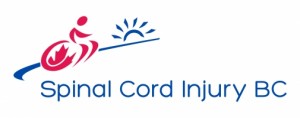 Nordic Ski Day – March 7!
Nordic Ski Day – March 7!
Ever wanted to try nordic sit-skiing? Now’s your chance! Join SCI BC and Whistler Adaptive Sports for a day on the groomed cross-country ski trails of Callaghan! Enjoy over 50 kilometres of groomed cross-counrty ski trails for all levels of skiers at the Whistler Olympic Park. Click here for more information.
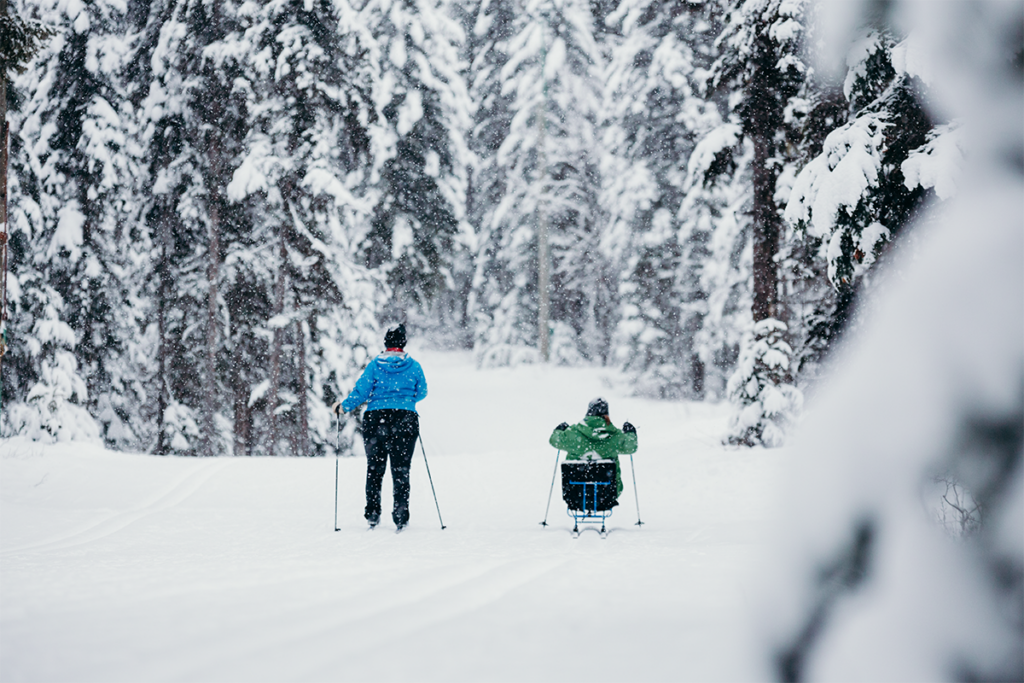
 RHFAC training courses confirmed for Spring 2020
RHFAC training courses confirmed for Spring 2020
by Hana Cairns, Marketing and Communications Manager, Rick Hansen Foundation
Rick Hansen Foundation Accessibility Certification™ (RHFAC) Training is once again taking place this Spring at post-secondary institutes across the country, including Vancouver Community College. This course teaches individuals how to use the RHFAC methodology to rate buildings on their level of meaningful access. Upon successful completion and passing the subsequent RHFAC Professional exam, individuals can obtain their RHFAC Professional designation, qualifying them to conduct RHFAC ratings within existing buildings and for pre-construction plans.
We are pleased to share that tuition funding is available for persons with disabilities who also meet the prerequisite requirements. For more information, and to see upcoming RHFAC Training courses, visit RickHansen.com/RHFAC or email access@rickhansen.com.
 Providence Health Care Research Institute, BC Children’s Hospital Research Institute and Vancouver Coastal Health Research Institute organize this annual public lecture featuring talks and a Q&A panel with clinicians and scientists on leading-edge health research. Attendance is FREE but space is limited. Light refreshments will be provided.
Providence Health Care Research Institute, BC Children’s Hospital Research Institute and Vancouver Coastal Health Research Institute organize this annual public lecture featuring talks and a Q&A panel with clinicians and scientists on leading-edge health research. Attendance is FREE but space is limited. Light refreshments will be provided.
Tuesday, March 10, 6-7:30pm
St. Paul’s Hospital, 1081 Burrard St., Vancouver
Click here for more information and to register
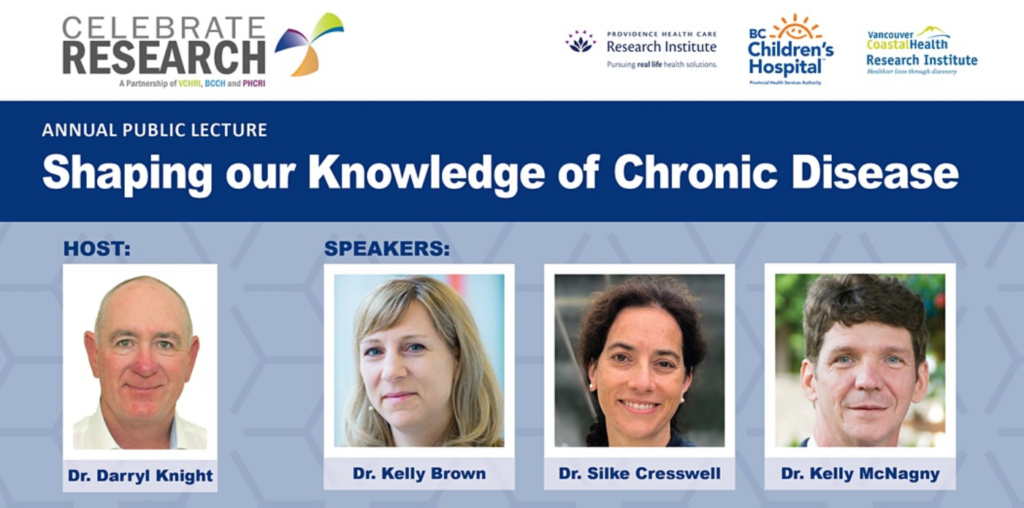
 Share your perspectives on spinal cord stimulation research and clinical trials!
Share your perspectives on spinal cord stimulation research and clinical trials!
by Katherine Chow
Praxis Spinal Cord Institute and NASCIC are conducting an online research survey on spinal cord stimulation. This research survey was co-created by people with lived experience of SCI to identify priorities, share expectations and assess demand for spinal cord stimulation. Spinal cord stimulation has shown potential for functional improvement for people living with spinal cord 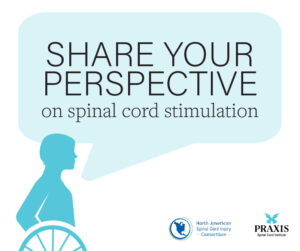 injury. However, the perspectives of those living with SCI have rarely been sought on this topic. We’re seeking input from people with lived experience of SCI and their primary caregivers about their opinions on this area of research. If you are interested, please take the research survey here. It should take approximately 15-20 minutes and will close on Tuesday, March 31, 2020. If you have any questions, please contact research@praxisinstitute.org.
injury. However, the perspectives of those living with SCI have rarely been sought on this topic. We’re seeking input from people with lived experience of SCI and their primary caregivers about their opinions on this area of research. If you are interested, please take the research survey here. It should take approximately 15-20 minutes and will close on Tuesday, March 31, 2020. If you have any questions, please contact research@praxisinstitute.org.

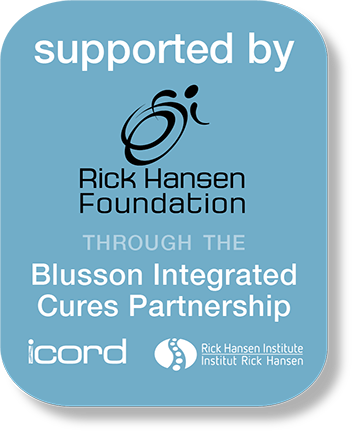 ICORD and the Praxis Spinal Cord Institute are working together to identify new treatments for SCI and apply existing treatments for other neurological disorders, injuries and diseases to SCI. Funded by the Rick Hansen Foundation, the Blusson Integrated Cures Partnership provides ten years of stable funding for several multi-year research projects as well as new faculty positions within ICORD, international exchanges to encourage collaboration, research-related events (like the Annual Research Meeting and seminar series) and a consumer engagement strategy which aims to provide people with SCI and their supporters with evidence-based information about the healthcare, services and resources available to best support recovery after SCI and increase consumer involvement in the research process.
ICORD and the Praxis Spinal Cord Institute are working together to identify new treatments for SCI and apply existing treatments for other neurological disorders, injuries and diseases to SCI. Funded by the Rick Hansen Foundation, the Blusson Integrated Cures Partnership provides ten years of stable funding for several multi-year research projects as well as new faculty positions within ICORD, international exchanges to encourage collaboration, research-related events (like the Annual Research Meeting and seminar series) and a consumer engagement strategy which aims to provide people with SCI and their supporters with evidence-based information about the healthcare, services and resources available to best support recovery after SCI and increase consumer involvement in the research process.
We are very grateful for this generous support.

Thanks for reading this issue of The ICORDian – we hope you enjoyed it! Please subscribe and have future issues delivered to your inbox. If you have any comments about this issue or suggestions for future ones, please contact us.


